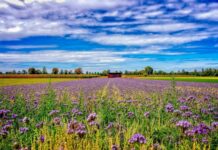By: Jane Marsh
Farming is the foundation for a stable society, providing food security to citizens and support for every other kind of economic growth. Currently, agriculture accounts for a large portion of total exports out of Africa.
With the global population rising and much arable land located in Africa, farmers have a unique opportunity to reinvest in their communities by developing their businesses. Here are five tips for planning your crop farm in 2022.
1. Improve Soil Health
Improving the health of your soil is the single best investment you can make for next year’s crop. Healthy soil is rich in nutrients and non-compacted so sufficient air and water can reach plants as they grow. Over time, a single crop that’s grown multiple times can deplete nutrients and lead to poorer yields every year.
As you plan what crops you’ll grow in 2022, consider rotation or using natural fertilizer to ensure healthy levels of nutrients to nourish your plants. Soil testing is the best way to determine the specific needs of your land. Planting a cover crop is another excellent way to protect and replenish soil over the winter.
2. Know Your Market
Finding a market can be one of the most challenging aspects of farming. Without one, even a surplus crop can mean losing money instead of making a profit. Before deciding what to grow next year, think about your buyers. Do you work with local restaurants? Will you need to pay transportation costs to take your produce to a nearby city?
The food you grow should ideally match a viable market that’s close by. If you’ve already established relationships, talk to buyers about what they’re looking for in the next year. If you’re just getting started, do some scouting. Look for opportunities, ask questions and see what others are doing before planning your crops.
3. Invest in Variety
Unfortunately, many factors that make for a good farming year are out of your control. Weather conditions, water availability and pest invasions vary each year. The best way to prepare for the unknowable is to grow various crops. In addition to improving security, this may increase your overall profit since some plants like saffron may be difficult to harvest but are very profitable.
Avoid counting on a single crop for return investment by planting multiple crops that will mature at different times of the year. That way, if locusts come in unexpectedly on a wind from Ethiopia, you’ll have another crop to fall back on later in the year. You can’t plan for everything, but variety can help protect you from unexpected, adverse environmental changes.
4. Order Materials Now
Global supply chain shortages are affecting farmers as well as many other major industries. Although you may be used to ordering machine parts and seeds later in the year, it’s a good idea to do so now for the 2022 crop. You should always plan carefully before ordering, so don’t rush your planning process to buy materials earlier.
A good solution may be to order materials in two shipments instead of one. Think about what is essential for your upcoming crop, and buy that immediately. After you finish your research, you can purchase the rest of your supplies. As the pandemic slows, many industry leaders remain hopeful that the supply chain will normalize soon.
5. Learn From Technology
The best way to scale up your farming business is by working smarter, not harder. New technologies in the farming sector can help you do that. The initial investment can pay off exponentially by increasing your overall production and the security of your plans.
Agro-tech can help you improve your soil health, turn dung into natural fertilizer, grow bumper crops without using soil at all, and protect against pests and drought. Some companies connect farmers digitally so they can share regional wisdom and get help when faced with a significant problem.
Although chemical pesticides may seem technologically savvy, they harm people and the environment over the long run. There are many technologies available to help you fight pests naturally. However, if you choose to use chemicals, ensure workers wear protective equipment so they aren’t harmed during the process.
Be Persistent
Planning crops for 2022 will take courage, ingenuity and a certain amount of flexibility. As crops and weather patterns play out, your farm will give you new information all year. Remember that farming is a long game, and some years are better than others.
Make it your mission to learn as much as you can this year, and take that knowledge into your next growing season. Never stop learning, trying new things and asking questions. Persistence is the key to building a successful farming operation and providing future food security for communities worldwide.









